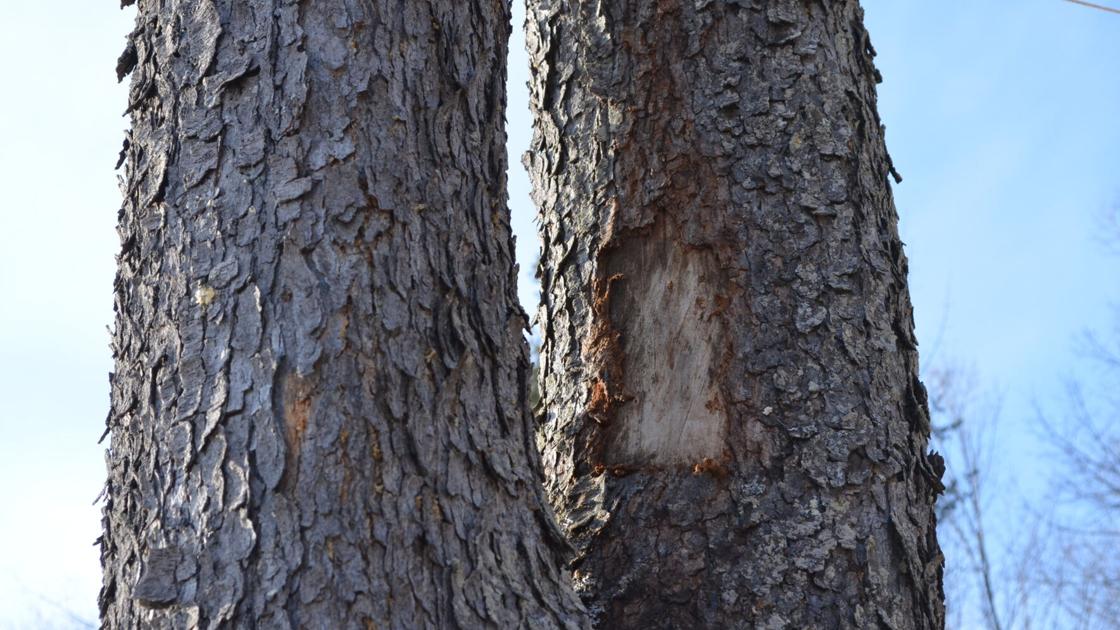
That old saying “March comes in like a lion and goes out like a lamb” has thus far proven to be at least half-true. The lion did come roaring in the first few days of this month with steady winds sometimes gusting to 60-plus mph. As a result, many trees or tree limbs came down, causing numerous power outages and some property damage. There were several similar damaging wind events last year, as well.
Well, we can’t stop the wind … nor a roaring lion … but these weather events should prompt an evaluation of the trees in our yards.
While expert evaluation of a tree’s structural integrity would require the hiring of a certified arborist, there are many things we can look for as warning signs of potential problems. These include decayed areas, cavities, cracks, peeling bark and fungal growths in tree trunks, as well as codominant trunks. Other warning signs are exposed roots, uneven shape or geometry of the crown, and dead or broken tree limbs.
Another important element is how tree limbs are attached. Ideally, the junction of branch to tree trunk should be U-shaped rather than V-shaped. The latter represents a weaker connection between branch and trunk, making the branch more susceptible to splitting away under high-wind situations or under the weight of snow and ice. The presence of any of these problems should be corrected ASAP, and may include removal of the tree to prevent serious property damage or threat to personal safety.
A key to good structure, and subsequent healthy growth, of a tree starts when planting new trees. Of course, proper planting procedure is important, but so is early pruning to create balanced branching, eliminating a codominant stems, and crisscrossing branches. Learn about proper planting and pruning if planning new additions to your landscape.
Hmm, if only we could tame that roaring lion.
THE GARDENING TASKS BEGIN
On the good news side, I did see a lamb this week and am feeling safe enough — for the moment — to take on these gardening tasks:
— Sketch a plan for this year’s vegetable garden. The goal of the plan is to prevent the planting of vegetables of the same family in the same place. In other words: rotate your crops. Crop rotation is a key element in a pest management strategy intended to reduce or eliminate pesticide applications. Many pests and diseases overwinter in the soil and are specific to different families of vegetables. By relocating crops of a given family to a different area of the garden each year, it is less likely that they will become hosts for a pest or disease. Of course, it is easier to follow a rotation scheme, preferably on a 3- or 4-year cycle, if you have sketches of each year’s planting scheme.
— Start seeds of cold tolerant vegetables, i.e. broccoli, cabbage, Brussels sprouts, cauliflower and lettuce indoors. To prevent seedlings diseases, such as damping-off, use a sterile germination medium. These typically are blends of sphagnum peat moss and perlite or vermiculite. I’ll sometimes add coarse sand or poultry grit in small quantities to the medium to encourage better drainage. Just as important as the medium is the use of clean containers when starting seeds. When re-using pots or containers, wash them in soap and water to remove old soil deposits and then spray them with hydrogen peroxide or a 10-percent bleach solution (1 part bleach in 9 parts water). Another option for seeding single plants is to use peat pots or cow pots. These decomposable pots do not need to be sterilized and are planted right into the ground with the seedling.
— Avoid the expense of costly herbs at the supermarket by growing your own. Now is the time to start seeds of basil, parsley, sage, rosemary, chives, tarragon and thyme indoors. Most herb seeds are slow to germinate. So to get decent size seedlings for transplanting to the garden or for growing in containers, start them now.
— Sow seeds of these annual flowers indoors soon since they are either slow to germinate or need extra growing time before reaching maturity and flowering: ageratum, annual aster, calendula, cornflower, impatiens, African marigold, pansy, petunia, annual phlox, geranium (Pelargonium), petunia, snapdragon, sweet William and zinnia.
— Cut branches of forsythia, flowering quince, ornamental cherry, lilacs, pussy willow, and other early-flowering shrubs and trees for forcing into early bloom. To force into bloom, simply place the stems in vases of water. Replace the water every two or three days. At this time of year, they should bloom in about 10 days.
— Get out the rain barrels. According to weather data at Pittsfield airport, the total amount of precipitation is already several inches below normal for the year. This may or may not be the trend for this year, but it is wise to be prepared.
Now, let’s hope that lion doesn’t crave lamb chops!
"condition" - Google News
March 11, 2021 at 01:30AM
https://ift.tt/3vfJjEO
Ron Kujawski: When March winds blow, it's time to check the condition of trees - Berkshire Eagle
"condition" - Google News
https://ift.tt/2W6ON50
https://ift.tt/2L1ho5r
Bagikan Berita Ini

















0 Response to "Ron Kujawski: When March winds blow, it's time to check the condition of trees - Berkshire Eagle"
Post a Comment